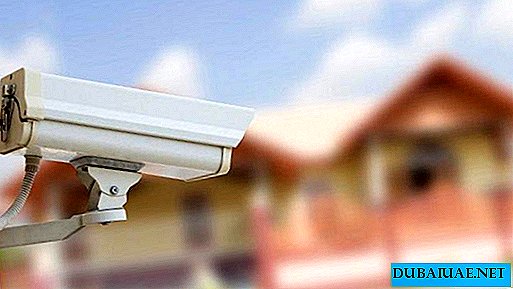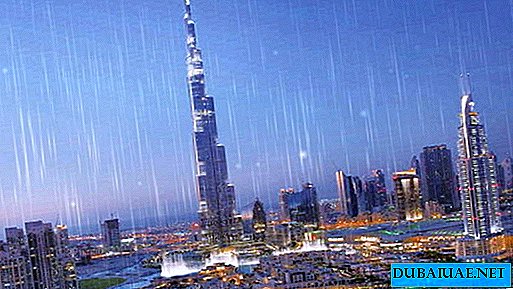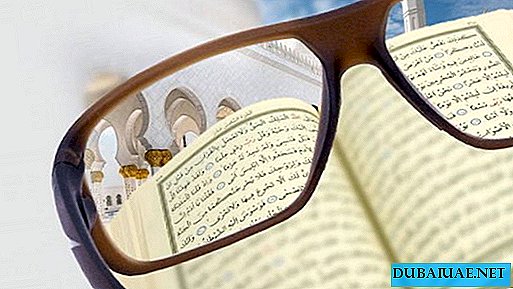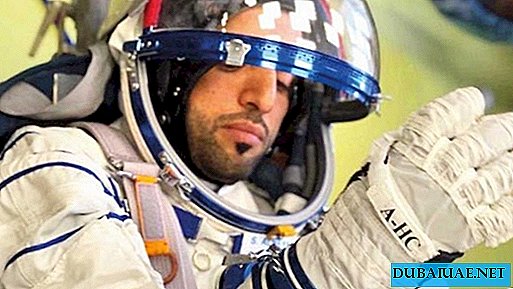Holy Islamic capital accepts Ramadan pilgrims

AND AGAIN THROUGH ABU-DABI, DUBAI, SHARJU WALKWAYS IDENTIFIED SHOPPED PEOPLE IN WHITE CLOTHES. Hundreds of thousands of Muslims, including from Russia and the CIS countries, on the days of the Islamic post of Ramadan through emirate airports, are sent to Mecca. THE CITY, THE NAME OF WHICH IN THE LANGUAGES OF THE PEOPLES OF THE EARTH BECAME A NAME NOMINAL, SYMBOLIZING THE MEDIUM OF PERFECTLY SPECIFIC UNIVERSAL INTERESTS, TAKING PILGRIMS ONCE AGAIN.
Their first goal is the main mosque of Mecca Al-Haram al-Mecca al-Sharif (Noble Meccan Immunity). Many of them will spend near the sacred building of the Kaaba, located in the courtyard of the mosque, all month. The culmination of the filling of the temple will be the Night of Predestination 27 Ramadan, when the Qur'an was revealed and, according to Islamic belief, Allah decides on the fate of believers, taking into account their piety and prayers expressed in prayers. Muslims believe that on this night angels descend from heaven for good deeds. Pilgrims will perform all five daily prayers here.
The story of Mecca, whose name is mentioned only with the epithet "Al-Mukarrama" (Noble), is associated with the settlement in these places of the prophet Ibrahim (Abraham), who came here from Palestine with his wife Ugar and the infant son, the future prophet Ismail. Figuratively called the "Mother of the Villages" the settlement grew, according to the Quranic definition, in a "valley without cereals", near the noble House of the Lord, called in Arabic the Kaaba. According to legend, this religious building was built by angels and was rebuilt several times, including with the participation of the “forefather of mankind” Adam and later by the hands of the prophets Ibrahim and Ismail. The hometown of the herald of Islam Muhammad ibn Abdullah is surrounded on all sides by mountains, from which waterfalls fall during the rainy season. According to Arab scholars, it dates back to 1871 BC, and throughout its great history was an important Arabian trading center, sending caravans to Syria and Yemen, trading with Egypt, Abyssinia, Mesopotamia and Persia. The population of Mecca, which during the first quarter of the 16th century conquered Hijaz in the first quarter of the 16th century, the Turkish Sultan Selim totaled 12 thousand inhabitants, exceeds, according to the Saudi press, at the beginning of 2007 3 million people.
 Mecca during the caliphs and Islamic conquests was widely upset and climbed the mountains, but remained one-story. The first Meccan house, the iconic Kaaba building, served as a model for the local and numerous foreign architects who built it. The henchmen dared to build taller buildings, but during the time of Caliph Muawiya ibn Abu Sufyan, the Meccan mayor Shiba ibn Osman ordered that all buildings towering over the Kaaba cube be removed. The first city educational institution, in which the lessons of faith were given, was also located in the sacred cube. The first real school, Al-Arsufi, was built in 1175 AD near the gates of Omra, the main Meccan mosque. A few years later there were already a few. With the expansion of education, dormitories for students, the first public kitchens and hospitals appeared. The architectural style of the city evolved with the participation of foreign pilgrims, who often stayed in the city for months and years. It was built by the best Islamic masters, who were not lacking. They enriched Mecca with elements of Egyptian, Syrian, Andalusian and Indian architecture.
Mecca during the caliphs and Islamic conquests was widely upset and climbed the mountains, but remained one-story. The first Meccan house, the iconic Kaaba building, served as a model for the local and numerous foreign architects who built it. The henchmen dared to build taller buildings, but during the time of Caliph Muawiya ibn Abu Sufyan, the Meccan mayor Shiba ibn Osman ordered that all buildings towering over the Kaaba cube be removed. The first city educational institution, in which the lessons of faith were given, was also located in the sacred cube. The first real school, Al-Arsufi, was built in 1175 AD near the gates of Omra, the main Meccan mosque. A few years later there were already a few. With the expansion of education, dormitories for students, the first public kitchens and hospitals appeared. The architectural style of the city evolved with the participation of foreign pilgrims, who often stayed in the city for months and years. It was built by the best Islamic masters, who were not lacking. They enriched Mecca with elements of Egyptian, Syrian, Andalusian and Indian architecture.
The Arab traveler Ibn Batuta, who visited Mecca more than 600 years ago, noted the integrity of the Meccans, their honesty, cleanliness, and willingness to help their neighbor. “The Meccans,” he wrote, “dress in white robes, love to smear themselves with perfumes, use antimony to color their hair, and use toothpicks made from araak wood.” The women of Mecca, according to his observations, "are amazingly beautiful and very chaste. Everything that is intended to buy food, they are ready to spend on incense." According to legends, back in the 10th century, one of the emirs of Mecca named Barakat ibn Muhammad, having found garbage near one of the houses, ordered his master to be beaten with sticks on the heels. So several people were punished. The executions did not pass without a trace. Mecca has become clean and remains so. The city was always well lit, even in times when there was no electricity. In the 13th century, according to one of the contemporaries of Sultan Abdel Hamid, 1,422 lamps illuminated the main Meccan mosque. Mecca began to rise for the first time when, in 754 AD, the first minaret 25 meters high was added to the mosque. He became a new measure of the height of the city. At the end of the last century, during the reconstruction of the main Meccan temple, 9 twin minarets, crowned with spiers with golden crescents, rose above its complex. Articles of Faith ascended to 89 meters high. And the city began to grow again. Several hundred high-rise buildings have already been built in the holy Islamic capital.
 According to the Meccan lunar calendar, the world's largest clock will soon be counted, which, according to the instructions of the Guardian of the Two Noble Temples, King Abdullah ibn Abdel Aziz, is supposed to be raised to the top of the 380-meter tower designed in the city of the Islamic prophet. Four gigantic chronometers will be turned on all cardinal directions. Above their dials the word "Allah" will be placed in the form of a crown. They will be decorated with golden arabesques depicting phrases from the Koran. The diameter of the two main clocks will be 39 meters. Their height along with the external design will reach 80 meters. The diameter of the pair of others will be equal to 25 meters, and their height will approach 65 meters. Under the clock, it is planned to create observation platforms provided with elevators, from which pilgrims will be able to observe the Meccan surroundings and ritual routes.
According to the Meccan lunar calendar, the world's largest clock will soon be counted, which, according to the instructions of the Guardian of the Two Noble Temples, King Abdullah ibn Abdel Aziz, is supposed to be raised to the top of the 380-meter tower designed in the city of the Islamic prophet. Four gigantic chronometers will be turned on all cardinal directions. Above their dials the word "Allah" will be placed in the form of a crown. They will be decorated with golden arabesques depicting phrases from the Koran. The diameter of the two main clocks will be 39 meters. Their height along with the external design will reach 80 meters. The diameter of the pair of others will be equal to 25 meters, and their height will approach 65 meters. Under the clock, it is planned to create observation platforms provided with elevators, from which pilgrims will be able to observe the Meccan surroundings and ritual routes.
For centuries, Mecca has been known not only for religious shrines and hot summits, but also for its rich markets - the most prosperous city in the kingdom. Visits by foreign Muslims to the holy sites of Islam bring huge income to Meccan homeowners. "Guests of Allah" take in Mecca 900 hotels and residences. Pilgrims rented several hundred high-rise buildings. A ten-day stay in two dozen 5-star hotels near the main temple costs one pilgrim $ 5,000. Accommodation during the same period in remote 3-4-star hotels costs 1-2 thousand dollars. Owners of guest houses, tent camps, car parks and restaurants earn $ 5-6 billion annually on pilgrims. Foreign Muslims leave about one and a half billion dollars in Saudi markets. The Saudi press estimates tens of billions of dollars in investment coming to Mecca. The role of the city in the economic life of the country is constantly growing over the past decades. Cramped by the mountains, he leads the country in the field of eggplant cultivation, but does not have the capacity to conduct expanded agricultural production. Many food and water are imported from other parts of the country.
 The value of real estate, especially near the main Meccan mosque, is constantly growing. The price per square meter of Meccan rocky sand near the holy reaches reaches 150 thousand dollars. A few years ago, an apartment in one of the central Meccan areas was sold for $ 11.5 million. The main advantage of this expensive housing is that it is located in a multi-story tower built near the main Meccan mosque. It is also important that the windows of the premises located on the 18th floor overlook the courtyard of the temple and allow you to observe the rituals performed in it. The total area of the apartment, competing in value with a small provincial town, is 255 square meters. From which it follows that the price of a seat in this monastery with one capacious Arab sofa exceeds 100 thousand dollars. Mecca is the kingdom's largest business center. Over 30 percent of all Saudi companies and enterprises are registered here. It is even inferior to the capital Riyadh, where 28 percent of production complexes are based, and the most industrialized, oil-bearing East Province (16.5 percent).
The value of real estate, especially near the main Meccan mosque, is constantly growing. The price per square meter of Meccan rocky sand near the holy reaches reaches 150 thousand dollars. A few years ago, an apartment in one of the central Meccan areas was sold for $ 11.5 million. The main advantage of this expensive housing is that it is located in a multi-story tower built near the main Meccan mosque. It is also important that the windows of the premises located on the 18th floor overlook the courtyard of the temple and allow you to observe the rituals performed in it. The total area of the apartment, competing in value with a small provincial town, is 255 square meters. From which it follows that the price of a seat in this monastery with one capacious Arab sofa exceeds 100 thousand dollars. Mecca is the kingdom's largest business center. Over 30 percent of all Saudi companies and enterprises are registered here. It is even inferior to the capital Riyadh, where 28 percent of production complexes are based, and the most industrialized, oil-bearing East Province (16.5 percent).
Over the past 20 years, the population of Mecca, throughout its history engaged in the trade and service of religious rites, has increased by two and a half times and continues to grow by 5 percent per year. It is estimated that after another two decades, 5 million people will live in it. A city surrounded by mountains does not have the possibility of horizontal development. To unload the holy Islamic capital from the excess population, it is proposed to build satellite towns around it, introducing restrictions on the right to reside near holy places. It is expected that the central part of the old city, numbering about four millennia, will be provided only to pilgrims and their departments. Until a decision is made, the ancient Arab city rises along the mountain ledges and ascends to the sky. A unique investment project with a total value of $ 2.5 billion is being created next to the main Meccan mosque. It includes the construction of a gigantic residential complex with a record building area exceeding 1.4 million square meters. The construction will have eleven thousand living quarters for 35 thousand people. King Abdullah ibn Abdel Aziz, while still a crown prince, issued an act establishing a housing complex in the Jebel Bulbul area in Ajyad with the aim of using his income to maintain the main mosques of Mecca and Medina through an independent investment project. The complex will become the largest waqf property in the history of the Islamic community.
The tradition of alienation of public waqfs was first introduced in Islam by the prophet Muhammad. Having built the first mosque in Medina, he bequeathed it to the religious community, made it "acting alms for all Muslims until the day of the resurrection." The prophet said at the same time, as is noted in the legends about him, that "after the death of a person his work lives in only three cases: if he left active alms or useful knowledge, or a virtuous son." The tradition of alienation of property in favor of mosques and religious communities lives on to this day, passing through all eras of the Islamic empire.
Improving transportation in Mecca is becoming a hot issue due to the growing number of pilgrims visiting the city. Before World War II, no more than one hundred thousand people visited holy Islamic places in Saudi Arabia. The number of pilgrims has risen sharply in the 80s and is estimated in recent years in millions. About 2 million Muslims visit Mecca annually during the pilgrimage season, which takes a total of about two months. Over 4 million people perform minor Hajj (Omru) in the other ten months. It is expected that in the current decade, due to the facilitation of visa formalities, the oldest Arabian religious center will receive up to one million pilgrims per month.
To solve the transport problem, the city is considering a project for the construction of an overhead railway. It has already been discussed in the central Hajj commission, recognized as fit for sale and cost-effective. The road should go from Mecca, located in the central part of the Ibrahim Valley, to the urban suburbs of Mina and further to Mount Arafat, where there is a place of standing before Allah during the Hajj. Its construction is dictated by the need to facilitate the movement of pilgrims, who, when performing rituals, have to repeatedly walk a distance exceeding 10 kilometers. The Meccan authorities considered three options for solving the transport problem on ritual routes. Proposals included the construction of an underground subway and the opening of a tram line. The idea of creating a metro was rejected because of the high cost of punching tunnels in the rocks of the mountains. The laying of the tram line was found to be impractical due to the narrow route corridors used by the pilgrims on foot. The commission’s conclusion is clear: only a cableway provides a solution to the problem of moving an increasing number of pilgrims. The capacity of the railway line planned at the first stage is 17 thousand passengers per hour.
In Islam, the worship of monuments is not accepted. But natural human curiosity leads people in white robes to remarkable places in the legendary city. Having completed the ritual rituals, they bypass the historical sights of the holy capital associated with the life of the prophet and the initial period of Islam. Pilgrims flock to the city public library, which preserves the holiness of the place where, over 14 centuries ago, a square 10-window house was rebuilt during the time of King Abdel Aziz, where, according to legend, the prophet Muhammad was born. “Guests of Allah” can be shown the house of the first wife of the prophet Khadija, who accepted the school of experts on the Koran after perestroika, and caves in the surrounding mountains, in which the first divine revelations sent to Muhammad were heard. Separate historical buildings are reborn to life. The Meccan city authorities are rebuilding an ancient irrigation system that provided water to the holy Islamic capital more than 1000 years ago. The history of Mecca's water supply is connected with the name of the beautiful Zubeida, the wife of the famous Abbasid caliph Harun al-Rashid, who died in fairy tales and poems, who died at the end of the ninth century AD. The granddaughter of Caliph Mansour and the mother of Caliph Muhammad Honest, strolling through the Baghdad gardens and date groves, did not forget the homeland of their Arabian ancestors.
To Mecca from Baghdad, a caravan road, called the Zubeida Trail, was provided for her money, especially for Muslim pilgrims, with wells and inns. In the hometown of the prophet Muhammad, the water supply system bearing her name was built on the golden dirhams of the great abbasidka. The Zubeida Spring includes a series of canals and catchment areas that held rainfall in the surrounding mountains. According to the aqueduct system, water was directed from the Noaman Valley to the city to meet the needs of its inhabitants and pilgrims. Studies have shown that canals and collectors built in the oldest Arabian city in the millennium before last, and today can be used to meet the needs of its residents. Water collectors are being cleared, canals are being repaired, new aqueducts are being built. The Zubeida Spring will murmur again, quench the thirst of the Meccans and their guests, and give them the coolness brought from the dull green mountains.
 In Mecca and its suburbs, more than 10 thousand mosques built by the government and pious believers. The city is overpopulated. There are proposals to create satellite cities around it, to increase the cost of electricity and water within it to squeeze out a population that is not involved in ensuring the performance of religious rituals on the outskirts. The old city is proposed to give to pilgrims, intended for hotels and tourist facilities. These measures should also serve to increase security within the holy borders and on ritual routes that attract dishonest dealers and confidants of vice, who come to Mecca from around the globe. It is known that there is a khmyr near every temple, and we have to admit that the holy Islamic capital is not a safe city.The crime rate here, including cases of physical violence, is higher than in other Saudi cities.
In Mecca and its suburbs, more than 10 thousand mosques built by the government and pious believers. The city is overpopulated. There are proposals to create satellite cities around it, to increase the cost of electricity and water within it to squeeze out a population that is not involved in ensuring the performance of religious rituals on the outskirts. The old city is proposed to give to pilgrims, intended for hotels and tourist facilities. These measures should also serve to increase security within the holy borders and on ritual routes that attract dishonest dealers and confidants of vice, who come to Mecca from around the globe. It is known that there is a khmyr near every temple, and we have to admit that the holy Islamic capital is not a safe city.The crime rate here, including cases of physical violence, is higher than in other Saudi cities.
Older people among the pilgrims make up the majority. There are a lot of old people on ritual routes. Some of them perform the hajj with the desire to find the last peace on the land of the prophet, to be in the forefront on the day of the resurrection, in which every Muslim believes. In each Hajj season, pilgrims die on the way to the main Meccan temple as a result of traffic accidents and on ritual routes due to the tightness of the ritual places. Natural deaths occur due to old age, illness and physical exhaustion, and there are murders. In Mecca there are funeral services, the workers of which wash the deceased, provide shrouds, escorted to the last refuge. The holy Islamic capital has its own "mournful path" leading from the main Meccan temple towards the Al-Ma'alat cemetery, located in an elevated part of the city. On this road to "otherworldly life" during the Hajj season, car parking is prohibited so as not to interfere with the way of those who are being moved towards paradise. The cemetery has existed for more than 1400 years and has over 20 thousand graves. Many associates of the prophet are buried here.
On Al-Ma'alat, only Saudis and foreign Muslims living in Mecca are buried. According to the Saudi press, due to the tightness of the place, the old graves are opened two years after the burial. They are cleansed of dust and used again. The bones are reburied elsewhere. There are no foreigners in the cemeteries of Mecca and in its environs, everyone is equal, no one is isolated. There are no photographs, memorial stones, nameplates, gypsum urns, numbers, and the color of sand reigns. In previous seasons of the Hajj, Muslims of Russia and a number of other CIS countries left their graves here. Foreign pilgrims are buried in the Sharai and Adl cemeteries. The most frequent burials take place during ramadan. There are no indigenous Saudis among the grave diggers. The old Meccans who worked here left the earthly vale, finding no substitute for themselves. It is not customary to regret the pilgrims completing their journey on the holy paths of worship of Allah. "Only Allah is eternal."
/ Victor Lebedev /











